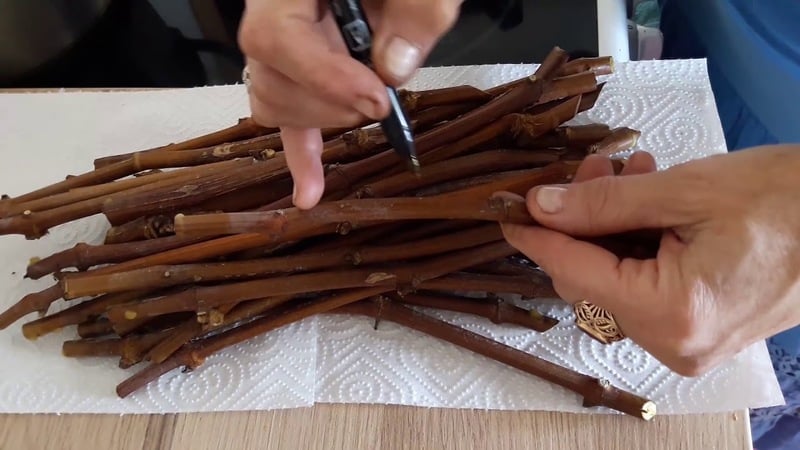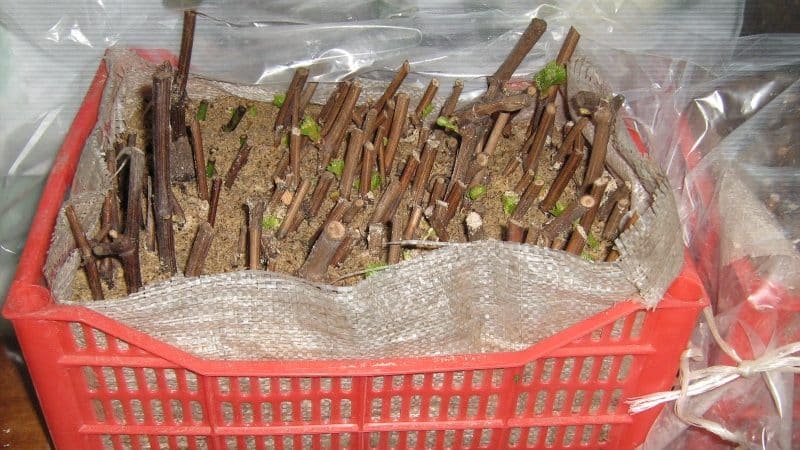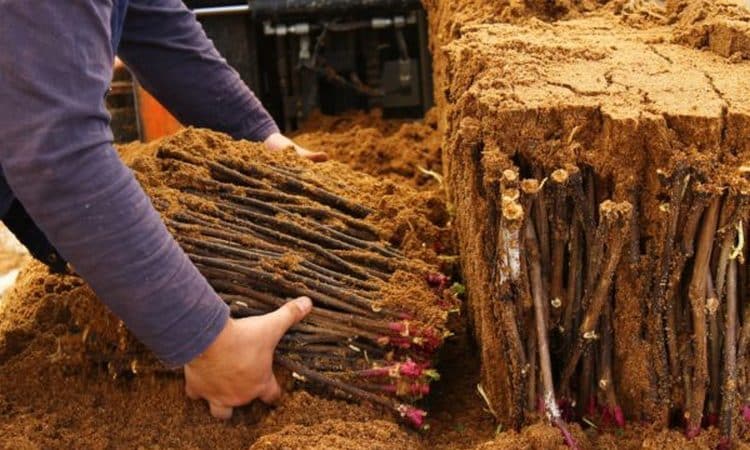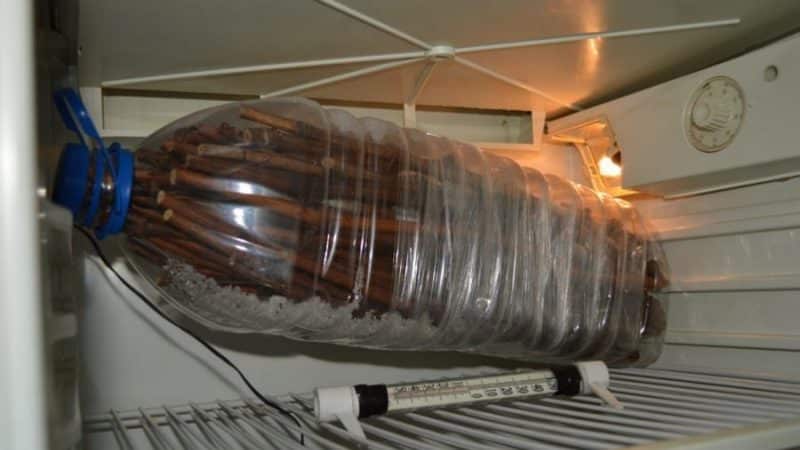Proven methods for storing grape cuttings in winter and checking them before planting
Grapes in the fall are subject to mandatory pruning, during which most of the vine is removed. From pruned annual vines, winegrowers cut cuttings that will give birth to new plants in the spring. Save them in winter Before the onset of the new season, a number of rules for preparing and maintaining cuttings will help.
Why harvest grape cuttings in the fall?
Cut cuttings are prepared for propagation of a favorite variety and increasing the amount of harvest. When growing a rare, demanding variety, it is advisable to root several cuttings as a safety net, so that if the vine becomes sick or freezes in winter, you will not be left without grapes. Extra chibouks can be exchanged with neighbors.
 Chubuki is prepared in the fall, after the leaves have fallen, usually in early November. The best time for trimmings The period from the first frost until the temperature drops to -8...-10°C is considered. At this time, the maximum amount of nutrients accumulates in the vine. In addition, it has already suffered the first hardening by frost, and cuttings from such a vine will be more hardy.
Chubuki is prepared in the fall, after the leaves have fallen, usually in early November. The best time for trimmings The period from the first frost until the temperature drops to -8...-10°C is considered. At this time, the maximum amount of nutrients accumulates in the vine. In addition, it has already suffered the first hardening by frost, and cuttings from such a vine will be more hardy.
How to choose them
In order for grape stems to survive the winter well and survive until spring, they need to be selected and prepared correctly.
It is important to choose a vine suitable for cuttings. She must be:
- matured this year;
- healthy, without spots on the bark, without mechanical damage;
- smooth, without curvature;
- crack slightly when bent;
- have a dense, not loose core.
To cut cuttings, use clean, sharp, well-sharpened garden scissors and knives. Blunt tools will crush the plant fibers of the cuttings you cut. Fattening shoots and barren bushes are not suitable for cuttings. It is better to give preference to vines grown on the sunny side of the vineyard.
How to cut
There are several rules for cutting pipes:
- it should have four developed buds, but it is better to cut off an area with 5-6 buds so that you can shorten the cuttings in the spring;
- for cuttings it is better to take the middle part of the vine;
- pipes should be no thinner than 0.5 cm and no thicker than 1 cm;
- the length of the cuttings is from 50 to 70 cm.
The lower part of the cutting is cut 3 cm below the internode, the upper cut is made 2-3 cm above the fourth internode on the cutting. The distance above the upper internode is left for future grafting. Remove all tendrils, leaves, stepsons.
Prepare for storage

Before storing for winter storage, the stems are disinfected, since the branches may contain bacteria and pathogens that will destroy the cuttings. Disinfection is carried out immediately after cuttings. Prepare a solution: 5 g of copper sulfate is dissolved in 200 ml of water. The solution is poured into a spray bottle, the stems are sprayed generously, and left to dry.
Reference! Disinfection of planting material will protect it from the formation of fungi and mold during winter storage.
It is important to saturate the chibouks with moisture so that they do not dry out during storage. With significant evaporation of the liquid, most of the eyes die. Planting material is soaked in a container of water for 24 hours. Then the segments are disinfected for 30-40 minutes in a solution of potassium permanganate.For better preservation, the sections are dipped in liquid paraffin - this will prevent the evaporation of moisture from the capillaries.
After all treatments, cuttings of one variety are tied in a bundle. The name of the variety must be attached to each bunch. Paper labels are not suitable for labeling, as mold forms on the paper in a humid environment. It is better to write the name of the variety on plastic labels. Each bundle is tightly wrapped in plastic wrap and placed in storage.
Buying grape cuttings
The best time to buy planting material is in the spring, just before planting. When purchasing ready-made seedlings, you don’t have to worry that the cuttings you harvested yourself will dry out or deteriorate due to poor storage.
Grape seedlings are divided into grafted or self-rooted. On grafted seedlings the grafting site is clearly visible. Grafted plants are more productive because they are grafted with a good variety. They are not affected by phylloxera. If, upon examination, the grafting site in the form of a growth is not visible on a smooth trunk, this is a sign of a rooted seedling. It is less productive, but in severe frosts the root system does not freeze.
When purchasing, pay attention to the following signs:
- A healthy plant has strong, well-developed roots. To check the condition of the roots, cut off a small piece of the root with a knife. Its cut should be moist and light. Dry, dark roots indicate the poor condition of the plant.
- The trunk of a healthy plant should be without damage. To check it, slightly open the bark fibers - a healthy plant will have green, moist wood underneath. A dry tree indicates that the seedling is drying out.
- Grape buds should not fall off when touched by hand.
Optimal conditions for preservation
Planting material is stored in dark places at a temperature of +1..+5°C. At lower temperatures the buds will die, and as the temperature rises they will begin to swell. To prevent dehydration of plants, maintain humidity at 90%. At the same time, they provide good ventilation to prevent the appearance of rot and mold.
Where to store cuttings
To store planting material, choose a dark place with low temperature and high humidity. Most often, a basement (cellar), a refrigerator, or a hole are dug on the site for these purposes.
In the basement

It is better to store a large number of grape shoots in the basement, if you have one. Low temperature and high humidity in these rooms contribute to high-quality storage of the prepared material.
The basement is periodically ventilated to eliminate excessive dampness.. The branches are wrapped in damp cloth and placed in plastic bags. Periodically moisten the fabric.
The bundles are stored on the shelves in the basement. If there is a suitable container, the branches are placed in it, sprinkled with wet sand or sawdust. The container is covered with plastic wrap.
Grape harvests are regularly inspected. If stains of mold or rot are detected, the branches are taken out, wiped with a clean cloth and sprayed with a solution of copper sulfate. Then they are dried a little and placed in storage containers. It is better to replace sand and sawdust, as fungi remain in them. If the sand is dry, it is moistened with water.
Reference! The good thing about storing grape stems in the basement is that there are no sudden temperature changes.
In a refrigerator

If there is no basement, grape branches are stored in the refrigerator. This method is suitable if the number of plants is small and their length does not exceed 45-50 cm. The chubuks are wrapped in a damp cloth treated with a solution of copper sulfate and placed in a plastic bag.
The bundle is placed in the vegetable compartment or on a shelf in the refrigerator, where the temperature is within +2..+6°C. At the same time, make sure that the package does not touch the walls of the chamber; in this case, the grapes will freeze.
Attention! During storage, the color of the bark of the chibouks is periodically checked. The appearance of black spots indicates the appearance of rot.
In the hole
If there is no basement, then gardeners store a large number of preparations on their plot. In a convenient place, dig a hole 28-30 cm deep. The width of the pit depends on the number of prepared chibouks.
Low-lying areas are not suitable for constructing a pit, as water will accumulate in them after the snow melts. It is advisable to place the hole near the wall of the house, this will prevent the ground and planting material from freezing. A layer of wet sand or sawdust (6-7 cm) is first poured onto the bottom of the pit. Then the first layer of cuttings is laid, a 7-8 cm layer of sand is poured on top, then another layer of cuttings. The layers are alternated until all the chibouks are laid. Soil is poured onto the last layer of sand, and boards or slate are laid on top to protect against heavy rainfall.
Important! When laying in a pit, grape segments are not placed in plastic bags.
On the balcony
Wooden boxes are used for storage on the balcony. A layer of wet sand is poured onto the bottom of the boxes, then the first row of grape blanks. The layers are alternated; the last layer of sand is poured. The box is covered with film to protect the sand from drying out.When the air temperature drops significantly, the box is covered with blankets.
The best option would be to store grapes in a glassed-in loggia. When frost sets in, the enclosed area of the loggia will protect the grapes from freezing and precipitation.
How to properly store until spring
The cuttings are periodically inspected. If rot or mold is detected, the shoots must be treated urgently. Moldy pipes are washed with running water and disinfected with a 3% solution of copper sulfate and potassium permanganate.
Overdried specimens are soaked in a container of water for 5-7 hours, then dried with paper napkins. To avoid drying out, the material in which the cuttings are stored - sand, sawdust - is periodically irrigated with water from a spray bottle.
Storage methods
Various storage containers are used for storage. You can install branches in a vertical position in large flower pots, buckets filled with loose soil. With this method, when the temperature rises above +6°C, the cuttings can begin to take root. In this case, they are simply planted in the prepared place in the spring.
You can store grape segments in plastic bottles with the neck cut off. At the same time, wet sand is poured into the container, into which the branches are placed. The plastic container is wrapped with transparent film.
Storage in moss (sphagnum) gives good results. It can be purchased at garden centers. The branches are wrapped with moistened sphagnum, placed in plastic bags, and stored in the refrigerator. Sphagnum has a disinfecting effect - planting material will be reliably protected from the formation of pathogenic microflora. In addition, the moss maintains constant humidity in the bag with chibouks.
This is interesting:
When and how to properly transplant grapes to another place in the fall.
What mistakes to avoid
For high-quality storage of grape stems, follow expert recommendations.
You cannot keep cut branches in the air for a long time. This will lead to loss of moisture; even slight drying will reduce the seedling's chances of further germination. Immediately after pruning, the cuttings are processed and stored.
It is not allowed to store sections without access to air. If cuttings are stored in bags, they are periodically ventilated to remove condensation. Without access to fresh air in conditions of high humidity, mold and rot form on the chibouks.
If the temperature regime is not observed, the shoots may freeze and weaken. This will lead to complete unviability of future plantings.
How to check them before boarding
At the end of February, gardeners check the suitability of planting material before planting it on the site. To do this, take 1-2 specimens from a bunch of each variety and place them in water for germination. If after 3-5 days the buds begin to swell, it means that the grape shoots are well preserved - they are able to take root and germinate.
Conclusion
The suitability of planting material depends on the selected storage conditions and compliance with all temperature and humidity parameters. What matters is the quality of cuttings prepared for the winter and their processing before storage. During the winter period, constant revision of cuttings and timely elimination of emerging problems are important.